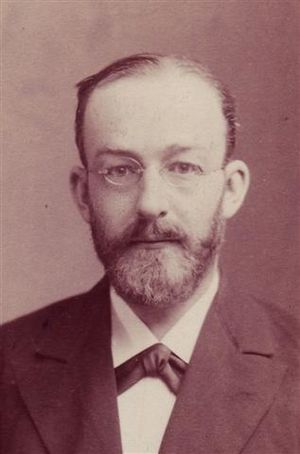Eberhard Nestle facts for kids
Eberhard Nestle (born May 1, 1851, died March 9, 1913) was an important German scholar. He studied ancient texts, especially the Bible. He is best known for editing a very important Greek New Testament called the Novum Testamentum Graece. This book is still used by scholars today. His son, Erwin Nestle, later continued his father's work.
Contents
Life of Eberhard Nestle
Eberhard Nestle was born in Stuttgart, Germany. His father was Christian Gottlieb Nestle. Eberhard had a half-brother named Wilhelm Nestle, who was also a scholar.
His Studies and Work
From 1869 to 1874, Nestle studied at the University of Tübingen. He earned his doctorate by writing about the Hebrew and Greek versions of the Book of Ezekiel from the Bible.
After his studies, he focused on oriental languages, which are languages from the Middle East. He even wrote a grammar book for the Syriac language. Later in his life, he became very interested in checking and comparing different copies of the New Testament. This is called textual criticism.
Teaching Career
Between 1898 and 1912, Eberhard Nestle worked as a professor. He taught at the Evangelical Seminaries of Maulbronn and Blaubeuren.
Family Life
In 1880, he married Klara Kommerell. They had one son, Erwin Nestle. Sadly, Klara died in 1887. Three years later, in 1890, Eberhard married Elisabeth Aichele. They had five daughters and another son.
The Famous Greek New Testament
In 1898, Nestle published a guide to textual criticism. In the same year, he released the first edition of his Greek New Testament. It was titled Novum Testamentum Graece cum apparatu critico ex editionibus et libris manu scriptis collecto.
This special edition combined the work of other important scholars. These included Constantin von Tischendorf, Brooke Foss Westcott, Fenton John Anthony Hort, and Richard Francis Weymouth. Nestle's edition was published by the Württemberg Bible Society in Stuttgart.
His work helped to create a balanced Greek New Testament. It avoided favoring just one ancient manuscript, like the Codex Sinaiticus or the Codex Vaticanus. Instead, it looked at many different sources.
This edition became very important. The British and Foreign Bible Society started using it instead of older versions.
After Eberhard Nestle passed away, his son Erwin Nestle (1883–1972) took over the publication. Erwin worked hard to make the editions even better. From 1952, another scholar named Kurt Aland also helped with the updates. This important book is now often called "Nestle-Aland."
Works by Eberhard Nestle
Here are some of the books and studies Eberhard Nestle wrote:
- Psalterium tetraglottum graece, syriace, chaldaice et latine (1879) – A study of the Psalms in four languages.
- Syrische grammatik mit litteratur, chrestomathie und glossar (1888) – A Syriac grammar book.
- Veteris Testamenti graeci codices Vaticanus et Sinaiticus cum texto recepto collati, 1880, 2nd edition (1887) – A comparison of Greek Old Testament manuscripts.
- Marginalien und Materialen (1893) – Notes and materials for his studies.
- A Palestinian Syriac Lectionary containing lessons from the Pentateuch, Job, Proverbs, Prophets, Acts, and Epistles (1897) – A collection of readings from the Bible in Palestinian Syriac.
- Vom Textus Receptus des griechischen neuen Testaments: Ein erweiterter Vortrag (1903) – About the "Received Text" of the Greek New Testament.
- Einführung in das griechische Neue Testament, 3rd edition (Göttingen: 1909) – An introduction to the Greek New Testament.
See also
 In Spanish: Eberhard Nestle para niños
In Spanish: Eberhard Nestle para niños


